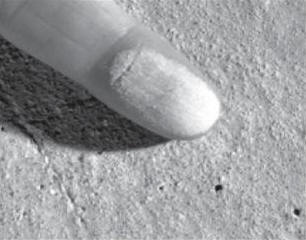

CIP #1 - Dusting Concrete Surfaces
WHAT is Dusting?

The formation of loose powder resulting from the surface disintegration of hardened concrete is called dusting or chalking. The characteristics of such surfaces are:
1) They powder under any kind of traffic.
2) They can be easily scratched with a nail or even by sweeping.
WHY Do Concrete Floors Dust?
A concrete floor dusts under traffic because the wearing surface is weak. This weakness can be caused by:
► Any finishing operation performed while bleed water is on the surface or before the concrete has finished bleeding. Working this bleed water back into
the top ¼ inch [6 mm] of the slab produces a very high water-cement ratio and, therefore a low-strength surface layer.
► Placement over a non-absorptive subgrade or polyethylene vapor retarder. This reduces normal absorption by the subgrade, increases bleeding and,
as a result, the risk of surface dusting.
► Floating and/or troweling operations following the condensation of moisture from warm humid air on cold concrete. In cold weather, concrete sets
slowly-- in particular, cold concrete in basement floors. If the humidity is relatively high, water will condense on the freshly placed concrete, which, if troweled
into the surface, will cause dusting.
► Inadequate ventilation in enclosed spaces. Carbon dioxide from open salamanders, gasoline engines or generators, power buggies or mixer engines may
cause a chemical reaction known as carbonation, which greatly reduces the strength and hardness of the concrete surface.
► Insufficient curing. This omission often results in a soft surface skin, which will easily dust under foot traffic.
► Inadequate protection of freshly placed concrete from rain, snow or drying winds. Allowing the concrete surface to freeze will weaken the surface and
result in dusting.
HOW can Dusting be Prevented?
® Concrete with the lowest water content with an adequate slump for placing and finishing will result in a strong, durable, and wear-resistant surface. In general,
use concrete with a moderate slump not exceeding 5 inches [125 mm]. Concrete with a higher slump may be used provided the mixture is designed to produce
the required strength without excessive bleeding and/or segregation. Water-reducing admixtures are typically used to increase slump while maintaining a low
water content in the mixture. This is particularly important in cold weather when delayed set results in prolonged bleeding.
® NEVER sprinkle or trowel dry cement into the surface of plastic concrete to absorb bleed water. Remove bleed water by dragging a garden hose across the
surface. Excessive bleeding of concrete can be reduced by using air-entrained concrete, by modifying mix proportions, or by accelerating the setting time.
® DO NOT perform any finishing operations with water present on the surface or while the concrete continues to bleed. Initial screeding must be promptly
followed by bull floating. Delaying bull floating operations can cause bleed water to be worked into surface layer. Do not use a jitterbug, as it tends to bring
excess mortar to the surface. DO NOT add water to the surface to facilitate finishing operations.
® Do not place concrete directly on polyethylene vapor retarders or non-absorptive subgrades as this can contribute to problems such as dusting, scaling, and
cracking. Place 3 to 4 inches [75 to 100 mm] of a trim-able, compactable fill, such as a crusher-run material, over vapor retarders or nonabsorptive subgrade
prior to concrete placement. When high evaporation rates exist, lightly dampen absorptive subgrades just prior to concrete placement, ensuring that water does
not pond or collect on the subgrade surface.
® Provide proper curing by using liquid membrane curing compound or by covering the surface with water, wet burlap, or other curing materials as soon as
possible after finishing to retain moisture in the slab. It is important to protect concrete from the environment at early ages.
® Placing concrete in cold weather requires concrete temperatures exceeding 50°F [10°C], as well as an accelerating admixture.
HOW is Dusting Repaired?
1) Sandblast, shot-blast, or use a high-pressure washer to remove the weak surface layer.
2) To minimize or eliminate dusting, apply a commercially available chemical floor hardener, such as sodium silicate (water glass) or metallic zinc or magnesium
fluosilicate, in compliance with manufacturer’s directions, on thoroughly dried concrete. If dusting persists, use a coating, such as latex formulations, epoxy
sealers, or cement paint.
3) In severe cases, a serviceable floor can be obtained by wet-grinding the surface to durable substrate concrete. This may be followed by properly bonded placement
of a topping course. If this is not practical, installation of a floor covering, such as carpeting or vinyl tile covering, is the least expensive solution to severe dusting.
This option will require some prior preparation since adhesives for floor covering materials will not bond to floors with a dusting problem and dusting can permeate
through carpeting.
|
Follow These Rules to Prevent Dusting
® Use moderate-slump concrete not exceeding 5 inches [125 mm].
® Do not start finishing operation while the concrete is bleeding.
® Do not broadcast cement or sprinkle water on concrete prior to or during finishing operations.
® Ensure that there is adequate venting of exhaust gases from gas-fired heaters in enclosed spaces.
® Use adequate curing measures to retain moisture in concrete for the first 3 to 7 days.
|
References
1. Guide for Concrete Floor and Slab Construction, ACI 302.1R. American Concrete Institute, Farmington Hills, MI.
2. Slabs on Grade, Concrete Craftsman Series CCS-1, American Concrete Institute, Farmington Hills, MI.
3. Concrete Slab Surface Defects: Causes, Prevention, Repair, IS 177, Portland Cement Association, Skokie, IL
4. The Effect of Various Surface Treatments, Using Zinc and Magnesium Fluosilicate Crystals on Abrasion Resistance of Concrete Surfaces, Concrete Laboratory
Report No. C-819, U.S. Bureau of Reclamation.
5. Residential Concrete, National Association of Home Builders, Washington, DC.
6. Trouble Shooting Guide for Concrete Dusting, Concrete Construction, April 1996.
1978, 1990, 1998
![]()